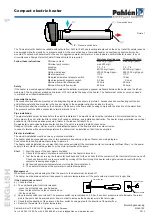
7
ROBERTSHAW 47484A PILOT SENSOR
ROBERTSHAW DERHC-S7C NATURAL 1" x 1" GAS VALVE
GAS VALVE
The gas valve is used to supply the gas to the unit during heat up periods.
The ignition control module monitors the thermostat's call for heat and
sends a signal to the gas valve when to open to allow gas flow.
PRESSURE SWITCH
The Blocked Outlet/Prover switch is set up to shut the unit off when a
pressure buildup in the exhaust vent pipe occurs. This switch is a
negative pressure switch that requires an increase in negative pressure
to change the electrical contacts from normally open to closed. The
switch is connected to the pressure tap connected to the housing of
the blower. When this switch prevents the unit from ignition, most
likely the exhaust is blocked by some means. Check for obstructions
in the exhaust vent terminal.
The Blocked Outlet/Prover switch has a second function. It is provided
on the heater to verify that the fan is operating. When the fan increases
in negative pressure, the electrical contacts close signaling that the
blower is operational and is at peak performance. The controller
requires that the electrical contacts on the switch close before it will
allow the burners to operate.
MPL 9300VO AIR PRESSURE SWITCH
between 15 and 25 psi (103 kPa and 173 k Pa). Flow pressures above 25
psi (173 kPa), or below 15 psi (103 kPa), will result in improperly sanitized
dishes. Where pressures are high, a water pressure reducing or flow
regulating control valve should be used in 180°F (82°C) line to the
dishwashing machine, and should be adjusted to deliver water between
these limits.
The National Sanitation Foundation also recommends circulation of 180°F
(82°C) water. Where this is done, the circulation should be very gentle so
that it does not cause any unnecessary turbulence inside the water
heater. The circulation should be just enough to provide 180°F (82°C)
water at the point of takeoff to the dishwashing machine. Adjust flow by
means of the plug cock in the circulating line.
FIGURE 3
ROBERTSHAW SP715A IGNITION CONTROL MODULE
NATURAL GAS MODEL
ELECTRONIC IGNITION CONTROL
Each heater is equipped with an ignition control module (See figure 3
above). The solid state ignition control ignites the pilot burner gas by
creating a spark at the pilot assembly. Pilot gas is ignited and burns
during each running cycle. The main burner and pilot gases are cut off
during the OFF cycle. Pilot operation is proven by the pilot sensor.
Main burner ignition will not occur if the pilot sensor does not first
sense pilot operation.
PILOT ASSEMBLY
The pilot assembly is mounted between the two middle burner
assemblies in the combustion chamber. The ignition sequence begins
with the ignition module sending voltage to the sparker located on the
front side of the pilot hood. Pilot gas flow is initiated after the sparker
begins to spark. The spark across the pilot gas flow ignites the pilot
gas. Once the pilot gas is ignited, the flame sensor senses the flame
through flame rectification (which means that the module's signal
changes from an AC current to a DC current because the current can
now flow through the flame to the pilot hood which is grounded to the
unit). Once the sensor senses flame, the signal is sent back to the
module to open up the gas valve for the main burners.
ROBERTSHAW #6S24-6 PILOT ASSEMBLY








































